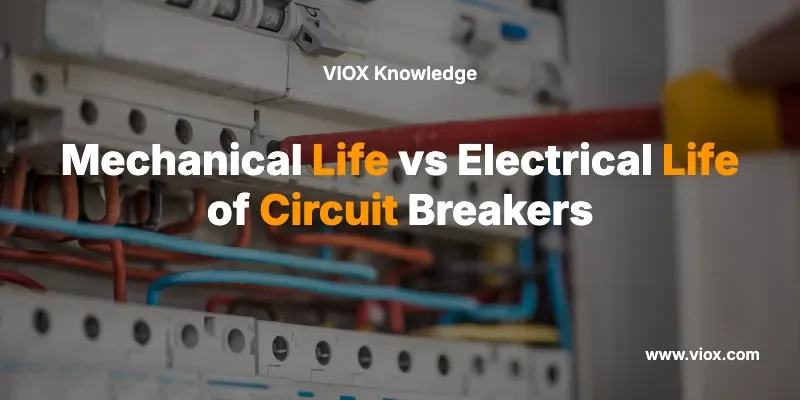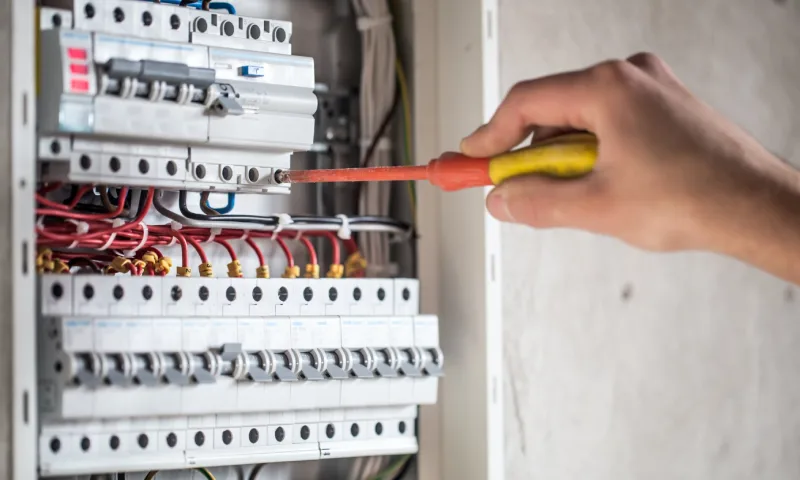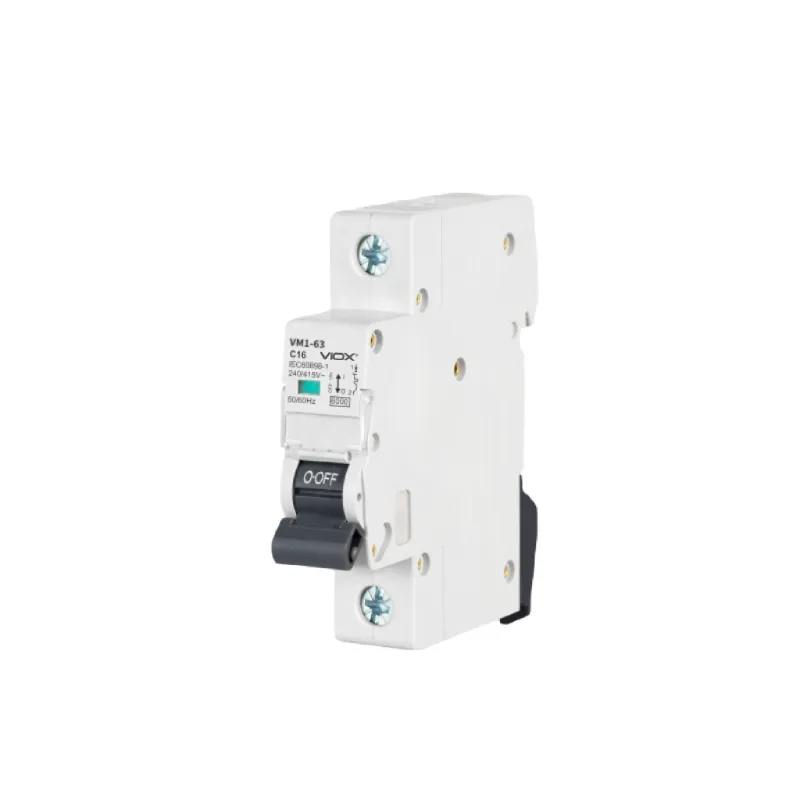سیدھا جواب: سرکٹ بریکر کی مکینیکل لائف سے مراد کھلے/کلوز آپریشنز کی کل تعداد ہے جو یہ بغیر بوجھ کے حالات میں انجام دے سکتا ہے، جب کہ برقی زندگی سے مراد وہ آپریشنز کی تعداد ہے جو یہ حقیقی برقی کرنٹ میں خلل ڈالتے ہوئے انجام دے سکتا ہے۔ مکینیکل زندگی عام طور پر برقی زندگی سے 10-50 گنا لمبی ہوتی ہے، 100-3000 سائیکلوں کے برقی آپریشنز کے مقابلے میں مکینیکل آپریشنز 10,000-30,000 سائیکلوں کے درمیان ہوتے ہیں۔
ان اختلافات کو سمجھنا مناسب ہونے کے لیے بہت ضروری ہے۔ سرکٹ بریکر انتخاب، دیکھ بھال کا شیڈولنگ، اور برقی نظام کی حفاظت اور وشوسنییتا کو یقینی بنانا۔
مکینیکل لائف اور الیکٹریکل لائف کیا ہیں؟
مکینیکل لائف کی تعریف
مکینیکل لائف افتتاحی اور بند ہونے والی کارروائیوں کی زیادہ سے زیادہ تعداد کی نمائندگی کرتی ہے جب سرکٹ بریکر انجام دے سکتا ہے۔ کوئی برقی رو نہیں اس کے ذریعے بہہ رہا ہے. یہ توڑنے والے کے رابطوں کی خالصتاً مکینیکل حرکتیں ہیں بغیر کسی برقی دباؤ یا قوس کی تشکیل کے۔
برقی زندگی کی تعریف
الیکٹریکل لائف ان آپریشنز کی زیادہ سے زیادہ تعداد کی نشاندہی کرتی ہے جس کے دوران سرکٹ بریکر انجام دے سکتا ہے۔ برقی رو میں رکاوٹ عام یا غلطی کے حالات کے تحت. ہر برقی آپریشن بریکر کو برقی دباؤ، قوس کی تشکیل، اور رابطہ کٹاؤ سے مشروط کرتا ہے۔
مکینیکل اور برقی زندگی کے درمیان کلیدی فرق
| پہلو | مکینیکل لائف | برقی زندگی |
|---|---|---|
| تعریف | بغیر موجودہ بہاؤ کے آپریشنز | کرنٹ میں خلل ڈالتے وقت آپریشنز |
| عام رینج | 10,000-30,000 سائیکل | 100-3,000 سائیکل |
| تناؤ کے عوامل | صرف جسمانی لباس | بجلی کا دباؤ + جسمانی لباس |
| قوس کی تشکیل | کوئی نہیں۔ | اہم arcing ہوتا ہے |
| کٹاؤ سے رابطہ کریں۔ | کم سے کم | ترقی پسند انحطاط |
| ٹیسٹنگ سٹینڈرڈ | IEC 62271-100, IEEE C37.09 | IEC 62271-100, IEEE C37.04 |
| بحالی کا اثر | متوقع پہننے کے پیٹرن | بجلی کی جانچ کی ضرورت ہے۔ |
آپریشنل تناؤ کا موازنہ
| تناؤ کی قسم | مکینیکل آپریشنز | الیکٹریکل آپریشنز |
|---|---|---|
| جسمانی لباس | چشمے، ربط، میکانزم | تمام مکینیکل اجزاء |
| انحطاط سے رابطہ کریں۔ | صرف سطحی آکسیکرن | آرک کٹاؤ، گڑھا، ویلڈنگ |
| درجہ حرارت کے اثرات | صرف محیطی درجہ حرارت | قوس درجہ حرارت (15,000°C+) |
| موصلیت کا تناؤ | کوئی نہیں۔ | ڈائی الیکٹرک خرابی کا خطرہ |
| گیس/تیل کی کمی | کم سے کم | آرکنگ سے سڑنا |
کیوں برقی زندگی نمایاں طور پر مختصر ہے
قوس کی تشکیل کا اثر: جب سرکٹ بریکر کرنٹ میں خلل ڈالتا ہے، تو افتتاحی رابطوں کے درمیان ایک برقی قوس بنتا ہے۔ یہ قوس:
- درجہ حرارت 15,000 ° C سے زیادہ تک پہنچ جاتا ہے۔
- رابطہ مواد کے کٹاؤ کا سبب بنتا ہے۔
- دھاتی بخارات اور گیس کی سڑن پیدا کرتا ہے۔
- برقی مقناطیسی قوتیں پیدا کرتا ہے۔
کٹاؤ کے عمل سے رابطہ کریں: ہر برقی آپریشن کے ذریعے رابطہ مواد کی خوردبین مقدار کو ہٹاتا ہے:
- تھرمل کٹاؤ آرک درجہ حرارت سے
- مکینیکل کٹاؤ برقی مقناطیسی قوتوں سے
- کیمیائی کٹاؤ آکسیکرن اور آلودگی سے
- بجلی کا کٹاؤ موجودہ کثافت کے اثرات سے
⚠️ حفاظتی انتباہ: کبھی بھی سرکٹ بریکرز کو ان کی ریٹیڈ برقی زندگی سے آگے نہ چلائیں کیونکہ یہ تباہ کن ناکامی، آگ، یا دھماکے کے خطرات کا باعث بن سکتا ہے۔
قسم کے لحاظ سے سرکٹ بریکر کی زندگی کی تفصیلات
کم وولٹیج سرکٹ بریکر (≤1000V)
| بریکر کی قسم | مکینیکل لائف | برقی زندگی | عام ایپلی کیشنز |
|---|---|---|---|
| چھوٹے (MCB) | 20,000 سائیکل | 10,000 @ ریٹیڈ کرنٹ | رہائشی، ہلکا کمرشل |
| مولڈ کیس (MCCB) | 10,000-25,000 سائیکل | 1,000-10,000 سائیکل | صنعتی تقسیم |
| موصل کیس (ICCB) | 10,000 سائیکل | 3,000-5,000 سائیکل | موٹر کنٹرول، فیڈر |
| ایئر سرکٹ (ACB) | 10,000-30,000 سائیکل | 1,000-8,000 سائیکل | اہم تقسیم |
میڈیم وولٹیج سرکٹ بریکرز (1kV-38kV)
| ٹیکنالوجی | مکینیکل لائف | برقی زندگی | کلیدی خصوصیات |
|---|---|---|---|
| ویکیوم | 10,000-30,000 سائیکل | 100-3,000 سائیکل | کم سے کم دیکھ بھال |
| SF6 گیس | 10,000-25,000 سائیکل | 100-2,000 سائیکل | اعلی مداخلت کی صلاحیت |
| ایئر بلاسٹ | 10,000 سائیکل | 500-1,500 سائیکل | میراثی ٹیکنالوجی |
| تیل | 5,000-10,000 سائیکل | 300-1,000 سائیکل | پرانی تنصیبات |
ہائی وولٹیج سرکٹ بریکرز (>38kV)
| وولٹیج کلاس | مکینیکل لائف | برقی زندگی | تنقیدی تحفظات |
|---|---|---|---|
| 72.5kV | 10,000 سائیکل | 100-500 سائیکل | ٹرانسمیشن ایپلی کیشنز |
| 145kV | 10,000 سائیکل | 100-300 سائیکل | گرڈ انٹرکنکشن |
| 245kV+ | 5,000-10,000 سائیکل | 50-200 سائیکل | اہم بنیادی ڈھانچہ |
سرکٹ بریکر کی زندگی کو متاثر کرنے والے عوامل
مکینیکل زندگی کے عوامل
- آپریٹنگ میکانزم کی قسم (بہار، ہائیڈرولک، نیومیٹک)
- محیطی درجہ حرارت اور نمی
- کمپن اور زلزلہ کے حالات
- بحالی کا معیار اور تعدد
- چکنا کرنے کی حالت
برقی زندگی کے عوامل
- فالٹ کرنٹ کی شدت (زیادہ کرنٹ = کم زندگی)
- قوس کا دورانیہ (تیز کھلنا = لمبی زندگی)
- پاور فیکٹر (آمدنی بوجھ زیادہ شدید)
- ریکوری وولٹیج (سسٹم وولٹیج کی بازیابی کی شرح)
- آپریٹنگ ترتیب (کلز اوپن بمقابلہ اوپن کلوز اوپن)
ماہر کا مشورہ: موٹر سٹارٹنگ ایپلی کیشنز میں استعمال ہونے والے سرکٹ بریکرز زیادہ انرش کرنٹ کی وجہ سے برقی زندگی میں کمی کا تجربہ کرتے ہیں، حالانکہ یہ تکنیکی طور پر خراب حالات نہیں ہیں۔
سرکٹ بریکر کی زندگی کے تقاضوں کا تعین کیسے کریں۔
مرحلہ 1: آپریٹنگ حالات کا تجزیہ کریں۔
- متوقع حساب لگائیں۔ مکینیکل آپریشنز فی سال
- اندازہ لگانا فی سال برقی آپریشن
- شناخت کریں۔ زیادہ سے زیادہ غلطی کی موجودہ سطح
- تعین کریں۔ ڈیوٹی سائیکل کی ضروریات
مرحلہ 2: ڈیریٹنگ فیکٹرز کا اطلاق کریں۔
| حالت | ڈیریٹنگ فیکٹر | درخواست |
|---|---|---|
| ہائی فالٹ کرنٹ | 0.5-0.8 | بجلی کی زندگی کو کم کریں۔ |
| بار بار سوئچنگ | 0.7-0.9 | مکینیکل زندگی کو کم کریں۔ |
| ناقص دیکھ بھال | 0.6-0.8 | دونوں پر لاگو کریں۔ |
| سخت ماحول | 0.8-0.9 | بنیادی طور پر مکینیکل |
| تنقیدی درخواست | 0.5-0.7 | قدامت پسند حفاظتی عنصر |
مرحلہ 3: مطلوبہ زندگی کا حساب لگائیں۔
مطلوبہ مکینیکل لائف = (سالانہ مکینیکل آپریشن × سروس سال) ÷ ڈیریٹنگ فیکٹر درکار برقی زندگی = (سالانہ الیکٹریکل آپریشن × سروس سال) ÷ ڈیریٹنگ فیکٹر
بحالی اور زندگی میں توسیع کی حکمت عملی
مکینیکل لائف ایکسٹینشن
- باقاعدگی سے چکنا کرنا آپریٹنگ میکانزم کی
- انشانکن سفر کی ترتیبات اور وقت کا
- معائنہ چشموں اور ربط کا
- ماحولیاتی تحفظ (حرارتی، وینٹیلیشن)
- کمپن کی نگرانی اہم ایپلی کیشنز میں
الیکٹریکل لائف ایکسٹینشن
- مزاحمت کی نگرانی سے رابطہ کریں۔ کٹاؤ کا پتہ لگانے کے لئے
- موصلیت کی جانچ ڈائی الیکٹرک سالمیت کی تصدیق کرنے کے لیے
- آرک چیمبر کا معائنہ آلودگی کے لئے
- متبادل سے رابطہ کریں۔ شرح شدہ زندگی کے 70-80% پر
- گیس/تیل کا تجزیہ سڑنے والی مصنوعات کے لیے
⚠️ پیشہ ورانہ تجویز: برقی جانچ مناسب حفاظتی طریقہ کار اور پی پی ای کا استعمال کرتے ہوئے قابل تکنیکی ماہرین کے ذریعہ کی جانی چاہئے۔
معیارات اور جانچ کے تقاضے
بین الاقوامی معیارات
- IEC 62271-100: ہائی وولٹیج سوئچ گیئر اور کنٹرول گیئر
- IEC 60947-2: کم وولٹیج سوئچ گیئر اور کنٹرول گیئر
- IEEE C37.04: AC ہائی وولٹیج سرکٹ بریکرز کے لیے درجہ بندی کا ڈھانچہ
- IEEE C37.09: AC ہائی وولٹیج سرکٹ بریکرز کے لیے ٹیسٹ کے طریقہ کار
جانچ کے زمرے
- ٹائپ ٹیسٹنگ - ڈیزائن کی ڈویلپر کی تصدیق
- معمول کی جانچ - ہر تیار شدہ یونٹ
- متواتر جانچ - سروس میں تصدیق
- حالت کی تشخیص - باقی زندگی کی تشخیص
سرکٹ بریکر کی زندگی کے لیے انتخاب کا معیار
جب مکینیکل زندگی بنیادی تشویش ہے۔
- لوڈ سوئچنگ ایپلی کیشنز (ٹرانسفارمرز, capacitors)
- ٹرانسفر سوئچنگ سسٹم
- مینٹیننس سوئچنگ آپریشنز
- ریموٹ کنٹرول ایپلی کیشنز
جب برقی زندگی بنیادی تشویش ہے۔
- قصور تحفظ کی ایپلی کیشنز
- موٹر شروع کرنا/روکنا
- آرک فرنس تحفظ
- کپیسیٹر بینک سوئچنگ
زندگی کے تقاضوں کے لیے فیصلہ میٹرکس
| درخواست کی قسم | ترجیحی عنصر | عام زندگی کا تناسب (M:E) |
|---|---|---|
| صرف تحفظ | برقی زندگی | 20:1 سے 50:1 |
| لوڈ سوئچنگ | مکینیکل زندگی | 10:1 سے 20:1 |
| موٹر کنٹرول | دونوں برابر | 5:1 سے 15:1 |
| کیپسیٹر سوئچنگ | برقی زندگی | 15:1 سے 30:1 |
اکثر پوچھے گئے سوالات
کیا ہوتا ہے جب ایک سرکٹ بریکر اپنی برقی زندگی سے زیادہ ہو جاتا ہے؟
جب برقی زندگی حد سے تجاوز کر جاتی ہے، تو رابطہ کٹاؤ ناکامی کا خطرہ بڑھاتا ہے، قوس میں خلل ڈالنے کی صلاحیت کم ہو جاتی ہے، اور بریکر محفوظ طریقے سے خرابیوں کو دور کرنے میں ناکام ہو سکتا ہے، ممکنہ طور پر سامان کو نقصان پہنچانے یا آگ کے خطرات کا باعث بن سکتا ہے۔
کیا مکینیکل لائف کو برقی زندگی میں تبدیل کیا جا سکتا ہے؟
نہیں، یہ الگ الگ ریٹنگز ہیں۔ بریکر کو برقی طور پر چلانے میں ہمیشہ مکینیکل اور برقی زندگی دونوں استعمال ہوتی ہے، لیکن مکینیکل آپریشنز صرف مکینیکل زندگی استعمال کرتے ہیں۔
آپ سروس میں سرکٹ بریکر کی زندگی کی نگرانی کیسے کرتے ہیں؟
مکینیکل آپریشنز کے لیے آپریشن کاؤنٹر استعمال کریں، برقی دباؤ کے لیے فالٹ کرنٹ مانیٹرنگ، رابطہ مزاحمت کی پیمائش، اور مینوفیکچرر کی سفارشات کے مطابق وقتاً فوقتاً دیکھ بھال کی جانچ کریں۔
شرح شدہ زندگی اور اصل زندگی میں کیا فرق ہے؟
شرح شدہ زندگی لیبارٹری ٹیسٹ کے حالات کی نمائندگی کرتی ہے۔ اصل زندگی کا انحصار آپریٹنگ ماحول، موجودہ سطح، دیکھ بھال کے معیار، اور مخصوص درخواست کے دباؤ پر ہے۔
کیا آپ کو ریٹیڈ لائف کے 100% پر سرکٹ بریکر کو تبدیل کرنا چاہیے؟
صنعت کی بہترین پریکٹس قابل اعتماد تحفظ اور حفاظتی مارجن کو برقرار رکھنے کے لیے ریٹیڈ الیکٹریکل لائف کے 70-80% پر تبدیلی یا بڑے ری فربشمنٹ کی سفارش کرتی ہے۔
فالٹ کرنٹ لیول برقی زندگی کو کیسے متاثر کرتا ہے؟
زیادہ فالٹ کرنٹ زیادہ سنگین حالات پیدا کرتے ہیں، جس سے برقی زندگی تیزی سے کم ہوتی ہے۔ 50% ریٹیڈ کرنٹ میں خلل ڈالنے والا بریکر 2-3 گنا طویل برقی زندگی حاصل کر سکتا ہے۔
کیا سرکٹ بریکر کی زندگی کو دیکھ بھال کے ذریعے بڑھایا جا سکتا ہے؟
مناسب دیکھ بھال کے ذریعے مکینیکل زندگی کو نمایاں طور پر بڑھایا جا سکتا ہے۔ رابطے کی تبدیلی کے ذریعے برقی زندگی کو جزوی طور پر بحال کیا جا سکتا ہے، لیکن خلل ڈالنے والے چیمبر کی زندگی محدود ہے۔
زندگی سے باخبر رہنے کے لیے کن دستاویزات کی ضرورت ہے؟
درست لائف اسسمنٹ اور ریگولیٹری تعمیل کے لیے آپریشن لاگز، فالٹ موجودہ ریکارڈ، دیکھ بھال کی تاریخ، ٹیسٹ کے نتائج، اور مینوفیکچرر لائف کروز کو برقرار رکھیں۔
ماہر انتخاب کے رہنما خطوط
نئی تنصیبات کے لیے:
- ڈیزائن کی زندگی پر متوقع کارروائیوں کا حساب لگائیں۔
- مناسب حفاظتی عوامل کا اطلاق کریں (عام طور پر 1.5-2.0)
- مستقبل کے نظام کی ترقی اور خرابی کی سطح پر غور کریں۔
- زندگی سے باخبر رہنے کے لیے نگرانی کی صلاحیتوں کی وضاحت کریں۔
موجودہ سسٹمز کے لیے:
- تاریخی آپریشن ڈیٹا کا جائزہ لیں۔
- جانچ کے ذریعے موجودہ حالت کا اندازہ لگائیں۔
- زندگی کی اہم حدود تک پہنچنے سے پہلے متبادل کی منصوبہ بندی کریں۔
- اعلیٰ زندگی کی ٹیکنالوجیز کو اپ گریڈ کرنے پر غور کریں۔
⚠️ اہم حفاظتی نوٹ: سرکٹ بریکر کی زندگی کی درجہ بندی بنیادی حفاظتی پیرامیٹرز ہیں۔ ریٹیڈ لائف سے تجاوز کرنے کے نتیجے میں فالٹ کرنٹ کو روکنے میں ناکامی ہو سکتی ہے، جس کے نتیجے میں تباہ کن سامان کو نقصان، آگ، یا عملے کو چوٹ پہنچ سکتی ہے۔ اہم ایپلی کیشنز کے لیے ہمیشہ مستند الیکٹریکل انجینئرز سے مشورہ کریں اور لائف ٹریکنگ کے لیے آپریشن کے تفصیلی ریکارڈ کو برقرار رکھیں۔
متعلقہ
IEC 60898-1 بمقابلہ IEC 60947-2: الیکٹریکل سرکٹ بریکر کے معیارات کے لیے مکمل گائیڈ
GFCI بمقابلہ AFCI: الیکٹریکل سیفٹی سرکٹ بریکرز کے لیے مکمل گائیڈ







